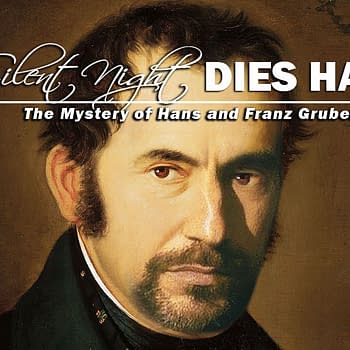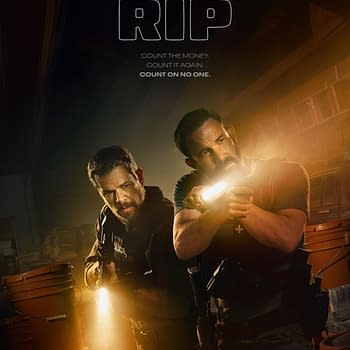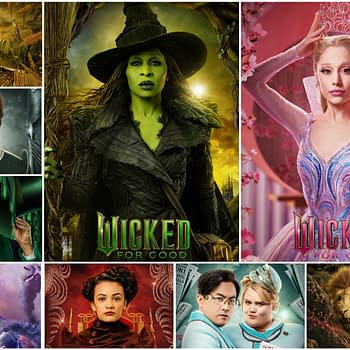Posted in: Movies, Recent Updates | Tagged: film, fritz lang, metropolis, movie posters
Is This Impossibly Rare 1927 Metropolis German 3-Sheet About To Set A New World Record For Movie Posters?

It is up for sale now at Movie Poster Exchange. Can this copy of the Metropolis German 3-Sheet break its own record?
The question intrigued me, because I know quite a bit about the vintage comics market but very little about movie posters. In the time since this poster set the world record for movie posters in 2005, the world record for a comic book sale has jumped from $350,000 to $2.16 million. Apples and oranges? Very likely, but when one of the people behind this offering, Sean Linkenback, sent me a notice that he and partner Peter Contarino were launching a new venue for collectors to buy and sell posters, I wanted to dig a little deeper into how this market works and where it's going.
Linkenback also knows the vintage comic market well. When I was getting into vintage comics in the late 1980s, he was writing market reports for the old Oversteet Comic Book Price Update — in those pre-internet times a treasure trove of information on how that market works. Since he understands both markets, I decided to pick his brain about how the movie poster market works, how it is differs from the vintage comics market, and how his startup intends to address the challenges that the growing market currently faces.
Bleeding Cool: Let's start with a little background on the Metropolis poster. When I saw this poster, I recognized it as one of the most famous images we now associate with the film. Is this German 3-sheet the original use of this art/design? Was this design used in other versions of the poster for other countries?
Sean Linkenback: Yes, this poster is the original use of this art. It was designed by Heinz Schulz-Neudamm and used only for the 3-sheet (both the German and International version). The International version is the one we are offering, it is identical to the German one except that it does not have the German credits printed on the poster. The copy in the Austrian National Library Museum is a "credits" version, and I guess the argument could be made it might even be more valuable than this, but since the museum isn't selling we will likely never know.
Most countries created their own posters for the film and were not forced by UFA to use the German designs. There is an excellent site here that shows many of these designs. Interestingly there isn't even a US one-sheet known on this film. There is a half sheet and an insert and several lobbies, but I don't even think a complete set of the lobbies exist.
What makes this poster potentially the most valuable movie poster in the world? In comics, we have sort of a pecking order of what we consider historically important and a general idea of what's rare, we see the supply/demand equation play out regularly in auctions, and I think these concepts have seeped into the mainstream to some extent. The average comic fan has a very general idea of what's valuable and why, particularly in recent years as high-profile auctions have gotten major publicity. It strikes me as a little surprising, given the size of the audience, that I don't think we could say the same about movie posters. This might be a tall order, but can you give me a general overview of what factors are important to poster collectors in terms of the importance of the film, rarity, versions of the poster, etc?
Posters aren't as quite an exact science as comics. There isn't an Action #1 equivalent, or even an Amazing Fantasy #15 equal when talking about 50s/60s posters. But there is a generally accepted pecking order and groupings as to what makes up the top tier posters, and for the most part they are almost all early Horror and Science Fiction titles.
Since the beginning of collecting, Universal Horror has been considered the top of the heap value-wise, with the one-sheets for their early films (Dracula, Frankenstein, Mummy, and Invisible Man) generally considered among the most expensive items in the hobby. The others that would comprise this core group are Metropolis (as the most famous and influential science fiction film ever) and the original King Kong. Sometimes an odd title pops on the list from time to time (Heritage sold a one-sheet for Flying Down to Rio for $239,000), but that core group generally comprises the Most Valuable list.

[ed. note: Since poster sizes and related terminology comes up frequently in this post, I asked Linkenback to give us a general overview:
In the US and UK, 3-sheets are 41" x 81", literally, the size of 3 one-sheets (27" x 41") turned on their side and stacked on top of each other.
Most other countries follow something close to this guideline, but because they are usually printed in more than one section (oddly enough most of the time two sections and not three), there can be size variations when the pieces are placed on top of each other, sometimes sections are printed full-bleed and meant to go exactly at the end of the other section, sometimes there is some blank white space at the end of one of the sections for theater owners to glue the opposite section to it, etc. And then just for fun, when the posters are linenbacked, the size could shrink or grow another 1/2" to 1" all around as the linen tightens or the paper relaxes as it's wet. So it can be confusing.
The 6-sheet is also equal to two 3-sheets stacked next to each other (or 6 one-sheets stacked in two rows on their sides), half sheets are about half the size of a one-sheet and so on.
I'd like to put this Metropolis poster in the context of some of the other most valuable movie posters in the world. Googling, I see the following as some of the top sales, for example:
- Metropolis, 1927, German 3-Sheet — $690,000 in 2005
- The Mummy,1932, One-Sheet Poster — $410,000 in 1997
- King Kong,1933, 6-Sheet Poster — $345,000 in 2008
- The Black Cat, 1934, One-Sheet Poster Style B — $334,600 in 2009
- Dracula, 1931, One-Sheet Poster Style F — $310,700 in 2009
- Frankenstein, 1931, One-Sheet Poster — $212,400 in 2009
If you could briefly comment on the rarity and importance to collectors of each of these and other top posters in the current marketplace, I think that would be very useful, and help people come to grips with what's important in this market and why. In particular, the Mummy 1997 sale stands out for obvious reasons. Would that poster give the Metropolis German 3-sheet a run for its money at the top spot if it came up for sale today?
These posters jockey back and forth on the "most valuable" list all the time, and of course each has its supporters and reasons why it should be above the others. All of them combine the best factors we look for: rarity, great image/artwork, and timeless appeal of the movie and characters.

- First is the 6-sheet for Frankenstein. This is currently owned by long-time collector Stephen Fishler and was featured in an episode of Hollywood Treasure recently. It is unique and not likely to enter the market for a long time.
- The second is also a Frankenstein poster, but the "teaser" style one-sheet which has a dark black background and a blood-red image of the monster. It is also unique and sold to collector Kirk Hammett for a price that would easily place it on the above list.
- The 3rd and 4th ones also belong to Kirk, being the "other" style Mummy one-sheet (which hasn't even been pictured in any poster books) and the 3-sheet for The Mummy which features a beautiful large image of Boris Karloff.
- The fifth and final would be the King Kong 3-sheet of the style which depicts him atop the Empire State Building holding Fay Wray and battling the bi-planes. While not unique, it certainly represents one of the most famous scenes in cinema from one of the greatest movies in history.
Is the entirety of what was produced historically (among desirable material, at least) relatively well known at this point? In other words, is the rarity such that it's possible that some original Frankenstein poster version that no one has seen before could surface even at this date? Are there any historically important posters which are known to have been produced yet no copies are known to exist?
Yes and no. Thankfully, even for movies where very little paper is known there is usually at least a pressbook known which will picture everything that was available for the theater owner to use. For example, Heritage has this great pressbook for the 1931 Dracula coming up in their next auction, so looking at the back cover we can see it pictures 3 different style one-sheets (with another pictured inside), two different 3-sheets, plus a 6 and 24-sheet poster. Now, we know there are single copies of the A and C style one-sheets known, two copies of the B style, and 4 copies of the F style. But so far, no copies of any of the larger posters have ever turned up. So collectors look at that image of the D-style 3-sheet with the full body image of Lugosi and Chandler and have nice daydreams of what could be out there waiting to be discovered.
As far as historically important posters go (and sticking to one-sheets which are the most collected size), there is at least one on most major titles — every Best Picture Academy Award winner, for example. There isn't a poster for Steamboat Willie, but Disney was just using stock posters at the time and printing the name of the cartoon on the poster, so if it were to turn up it would be great news, but visually disappointing at the same time.
Among genre films, there are still some rarities. I don't believe there are any US one-sheets known for London After Midnight (the famous lost Lon Chaney Sr. film) or for Mark of the Vampire, one of Lugosi's major roles. And by far the biggest missing title would be the original 1922 Nosferatu. I've never seen a single American piece on the film anywhere, and all the original German material was ordered destroyed by the courts back in the 20s. So you could take all the paper known from every country combined and still not come up with more than a handful of pieces.
There are certainly a number of important posters that are unique, though — like the A style one-sheet for Dracula I just mentioned, the Frankenstein teaser poster, or the one-sheet for the 1925 version of The Lost World.

It is much more accepted than in comics, and in the case of something like a 3-sheet, it is generally accepted that the only way to display it properly is to have the poster linenbacked which requires at least minimal restoration (as the poster was printed in multiple sections). [ed. note — from papersmith.net: "Linen backing is the process of reinforcing and stabilizing a poster by gluing it with wheat paste to acid free paper and light cotton canvas. Although not perfect, linen mounting has emerged as the most successful process for preserving and restoring posters." You can see video examples of this process here and here.]
Again, I think this goes back to the rarity issue. If there are only 4 copies of something known, and all of them have restoration, then not only is it a more level playing field, but there is no point in holding out for something that doesn't exist. As you get into items that might be more plentiful in existence than you can start to play the condition and restoration game, and we see if happening with more recent titles and certainly in the case of lobby cards – and even in lobby cards going back to the 30s. Heritage auctioned a CGC graded 8.5 unrestored Dracula lobby card for over $31,000 and a restored copy of that card might only bring half of that number. So there certainly is some divide, but nothing like in comics.
Aside from linenbacking, let's talk about other common poster restoration and how acceptable it is to the marketplace. I see you have mentioned (what we would call in comics) color touch on the Metropolis poster, along the fold lines. I presume that is commonly done? Are display issues paramount to the poster collector to the extent that a collector would prefer to have a piece replaced on a valuable poster rather than display it unrestored?
Pretty much in 99% of linenbacking, the fold lines on posters are at least lightly touched up. It's just accepted that if you are going to back the poster and flatten it out you would want to diminish the fold lines as much as possible. As far as displaying preferences it really depends on the collector (and the size of the missing piece). I have known some collectors to take it to the extreme and even linenback newer $25 posters as it's just what they do, and I know collectors who keep everything in the same condition as when they acquire the poster. Being that my background is in comics, I tend to follow the idea that condition will win in the end and on more common items (say 50s or 60s lobby cards or posters) I wait to buy items in the very best condition possible and have started having my lobby cards graded by CGC to get an idea of which ones I might wish to upgrade. Of course on very rare items you might have no choice but to buy a restored example as all known copies have been linenbacked or have some degree of restoration.

Yes, CGC-style grading is definitely something new in the poster market. I believe they started grading lobby cards (pretty much the only size that lends itself to encapsulation) just over a year ago and Heritage has auctioned some pieces with impressive results. I mentioned the Dracula already, but they have also done quite well with 50s sci-fi and horror that has been graded. Naturally a lot of old-school collectors are reluctant to take to grading, just as they were in comics, but I think the appeal of the restoration check, and the confidence in 3rd party grading will grow and be much more widely accepted.
There is really still no formally adopted grading terminology (for example some dealers use the condition term "excellent" and others don't, and "fine" can be one dealer's top grade while another will use comic book terminology), so we really hope to help standardize terminology and use of the ten point scale. A ten point scale is something that everyone can understand and relate to whether they are a collector or not.
As for authentication issues, the problem is two-fold: reproductions of newer popular titles (meaning late 70s and up), whether they were reproductions made overseas and intended for sale or made with an eye to deceive.
In the past couple of years, a massive fraud was uncovered in vintage 30s/40s horror posters were over a million dollars worth of fraudulent movie posters were discovered to have been made. The forger was very clever in using actual pieces of old posters and then heavily restoring and altering them to look like something different. Thankfully many of the items were rare enough that it quickly came to light what was happening when so many ultra-rare pieces were quickly entering the market and the FBI was able to track down and arrest the culprit.
I myself spent many hours with the FBI agent in charge of the investigation, helping them to identify fakes and the process used to make them. And we are keeping examples of fakes and reprints on hand to help identify and catch any that sellers might list even inadvertently on our site. I have no doubt that there are people out there who have bought fakes and have no idea that they own one. Pulp Fiction, for example, is one of the most popular titles of the past 15 years and there are literally hundreds of fakes of this poster out there, but we are able to spot these and keep our customers from ending up with one.
When you sent me the press release about your company, and noted that it was the first of its type in the movie poster field (comparing it to Comic Link and Comic Connect in comics), I was surprised to realize that as an outsider to this market, I don't really know where I'd go to buy/sell movie posters aside from Heritage Auctions.
It kind of still surprises me given how popular movies are that poster collecting is still so small. I think it really stems from the fact that posters were just never available to the public, you couldn't walk into a theater and buy one to take home — where could people get one if they wanted one? Combine that with the extreme rarity of many of the most desired pieces, and what sometimes is a cost-prohibitive barrier to entry. If you like Spider-man there will be a new issue almost every week that you can buy cheaply and start a collection, but if you like Bela Lugosi's Dracula, an entry level piece can be $1000 or more if it's an original from 1931, and still is in the hundreds for something from one of the various re-releases (Dracula was released back to theaters in 1938, 1947, 1951, and 1963). In fact even the one-sheet from the 1947 release is very rare with probably less than a dozen copies known and brings $40,000 or more when it does surface.

Yes. One of the great things about the Universal horror films is that a lot of them were re-released through the years. Dracula for example was re-released in 1938, 1947, and 1951. You can pick up lobbies from the later releases starting at under $100 for one without Lugosi to maybe $1500 or so for a great scene with Lugosi and the one-sheet from the 1951 release can be had for perhaps $5000 instead of the six-figures it would cost for the original. If your heart is set on something from 1931 a herald (which has great images of Lugosi) can be had in the $500-1000 range and of course the larger pieces go up from there in price.
I'm sure there are also other groups of popular historical material to look at if the Universal Monsters and the like are out of reach. I know you know the Godzilla market, so let me ask about giant monster posters. What are some of the stand-out posters in that area?
Well, of course I will be biased towards everything Godzilla related, and the original Japanese poster for the 1954 Godzilla movie is probably the most valuable giant monster poster and possibly the second most valuable 50s poster period. The most valuable 50s poster would be the rare War of the Worlds B-style half sheet which is the only US poster art to feature the Martian warships. Anything Creature From the Black Lagoon is always highly desired as well as items from the classic films Day the Earth Stood Still, and Forbidden Planet. Both have fantastic art on all their posters. The 50s were really a very creative and artistic time for science fiction and monster posters and a lot of the posters are much better than the movies (Attack of the 50 Foot Woman comes to mind immediately). Invasion of the Saucer-Men might feature the most iconic aliens in the "green men from mars" area and were the inspiration for the Mars Attacks card series later. As far as other giant monsters, probably the Beast From 20,000 Fathoms has the best artwork.

Super-hero posters are interesting, as just like in comics, there is a pretty well defined Golden Age, then a period of almost nothing and now of course a strong revival again with so many comic movies being produced.
The first, and by far the rarest, would be the one-sheet for the Fleischer Superman Cartoons. They produced a stock one-sheet, but it is a gorgeous full color poster with a great Shuster Superman image on it. It's also very rare with maybe a dozen copies known to exist. After that would be the posters for the 1940s serials: Batman, Captain America, Captain Marvel, Superman, Spy Smasher, Blackhawk, etc. There is a lot of great stuff here and while the one-sheets can be four-figures in cost, you can get lobby cards from most of the serials for a couple of hundred dollars or less.
There is a then a big drop-off until the Adam West Batman movie, which is hugely popular with collectors — and for good reason: most of the posters and lobbies feature large colorful images of Batman, Robin, Joker, Catwoman, and the other villains. Then of course there are the more recent cycle of comic films which really start with the 1978 Superman until present. Almost all of these are very affordable and you can pick up posters in the $20 – $75 range on most all of them with a few exceptions (The Heath Ledger Dark Knight poster consistently brings $150 or more).
Linkenback was kind enough to put up with several rounds of newbie questions for this piece, and as a longtime vintage comics collector who loves the smell of all kinds of old paper, I must admit the process of putting this post together has gotten me more than a little interested in further investigating vintage poster collecting. I'm off to google more about Fleischer Superman posters and daydream my way through the Heritage Auctions poster archive. In the meantime, if you're already a serious collector, you can grab the ultimate bragging rights with that Metropolis German 3-Sheet right here.















